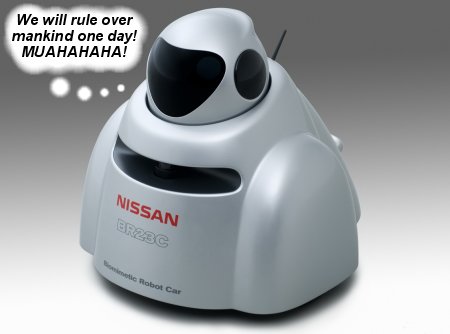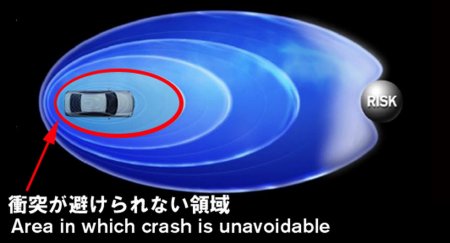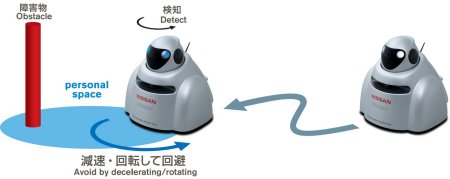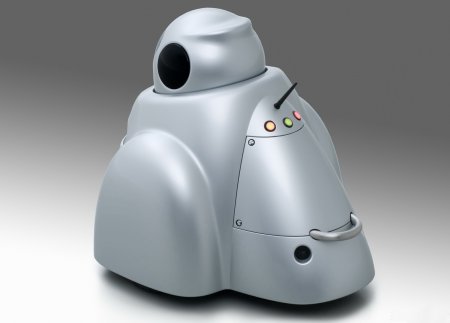Nissan develops bee-robot to avoid crashes

To be shown at the upcoming CEATAC show in Japan, Nissan has developed a system designed for cars that could automatically avoid collisions, using ideas garnered from the natural abilities of bees.
Co-developed with the Center for Advanced Science and Technology Research at Japan’s prestigious Tokyo University, Nissan has built the Bio-mimetic Car Robot Drive, or BR23C, a robotic micro-car that recreates bee characteristics with the goal of producing a system that prevents collisions altogether.

In flight, each bee creates its own oval-shaped personal space. It is the bee’s compound eyes, capable of seeing over 300-degrees in all directions that allows the bumblebee to fly uninterrupted inside its own personal space.
In order to recreate the function of a compound eye, engineers came up with the idea of a Laser Range Finder. The LRF detects obstacles up to two meters away within a 180-degree radius in front of the BR23C, calculates the distance to them, and sends a signal to an on-board microprocessor, which is instantly translated into collision avoidance.
The split second it detects an obstacle, the car/robot will mimic the movements of a bee and instantly change direction by turning its wheels at right angles or greater to avoid a collision. The biggest difference to any current system is that the avoidance manoeuvre is apparently instinctive. If that was not so, then the car robot would not be able to react fast enough to avoid obstacles.
The whole process must happen within the blink of an eye. But unlike a bee, it cannot deviate upwards or downwards or diagonally, only in two dimensions and only in the direction that the wheels can turn. So in place of the infinite number of ways a bumblebee can avoid other bees, Nissan has employed a rotation function, in addition to acceleration and deceleration as the car/robot’s means of collision avoidance.
The BR23C uses lithium polymer batteries, which are lighter and have higher energy density, meaning that they last longer than the lithium-ion variety.

Nissan says that the car/robot’s instincts are intelligent, and does not need to retain any memory or intuitive logic from previous manoeuvres, so it can operate continuously using as little as a couple of dozen KBs of memory.
This is the first step in developing instantaneous collision avoidance technology, which Nissan anticipates will find its way into production cars within ten years, as part of its Safety Shield project. One other possible future application could be to integrate the unit with a GPS sat-nav system so that it leads a driver to a destination, avoiding obstacles along the way.

Rest easy that these future systems will be integrated into actual cars, and not geeky-looking big-butted dork-mobiles.

Comments
Boris(K-sport)
haha! they look dorky! but you already said that. jokes aside, this is a great system but I think it will be a decade before they are available standard in global markets. they’ll keep it reserved for japan for probably 5 years and then make it optional on global models. But its a great system and its something they’ve been developing for some years now, I used to be a Nissan fan a couple o’ years ago and knew about it then too.
cb
sounds like a modified version of the laser guided cruise control. i wonder how they are gonna detect whether the car is on a bridge or not before maneuvering since i doubt it’ll detect the railing 🙄
khalid
future cars look so baaad 🙁 🙁 ,,, nothing like the 280zx or impala s.s. 1996,,,,or 2006 camry,,,, 2006 maxima,,, these are amzing cars including lumina s.s,, caprice s.s. 2001-2006,,, to me no futur car will compare to these stated.. 🙁 🙁 🙁
Boris(K-sport)
how old are ya? no offence. 😐
assassin
😕 😕
Good luck to them any way.
RayD
Khalid actually thinks it’s a passenger car?
Boris – you’re not a fan of Nissan anymore?
Boris(K-sport)
nissan’s on second for me now. I’m a big fan of HKAG. but I’ve never been a blind fan to any manufacturer and can accept if cars are better then of the make I’m a fan of. I really want to see a comparison of Mohave and Pathfinder or explorer.
vivek
nice thinking cb..well, with 180 degrees of real-time monitoring for obstacles, i guess it shud b able 2 detect the railings too..moreover, once it deviates the car from it’s path, the next thing in front wud b the railing; so it probably might turn the car back to it’s path, and by that time u wud’ve already avoided the previous obstacle..BINGO!..but imagine that u r on a single lane road wid deep gorges on both sides (and no railings)…an obstacle confronts the bee in the car, and the bee avoids the collision by turning the steering wheel…and there, u fly down like a bumblebeee!! 😆
hmm..wonder when i’ll get to see a real-life “knight-rider” on roads…no probs evn if it isn’t gon’ be a Mustang or Trans Am..whoever has seen the TV-series know what i’m talkin! 😉
thatsit(mohamad)
hahahahahaaaaaaay
really the way u solved CB’s problem was really perfect…but the second part i cant imagine it…hehehehe 😆 😆 😆
cb
hehe that doesn’t solve any problem..i doubt those lasers will detect something as small in size as railings..if thats the case then the mercedes with the laser guided cruise control should do an emergency brake anytime a bird flew in front of it
khalid
im 17 😈 😈 😈 😈
vivek
probably it doesnt detect something as small as a sparrow or a pigeon until the bird runs into the radar sensor!! 😛